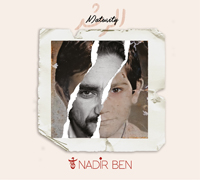
NADIR BEN
MATURITY (Joussour/Inouie)
Nadir Benmansour is a folk/pop singer in the Maghreb tradition. Born in Oran and raised in Tlemcen* he now lives in France. His longing for his Algerian homeland is manifest in his lyrics. His influences come from the Arabic mainstream as well as Gnawan music he recalled as a lad, and the Andalusian tradition which spanned the Mediterranean. Therefore Spanish guitar fits alongside krakrebs in his backing, along with violin, electric bass and percussion. We also hear sax, accordion, mandola and guimbri here and there. The Spanish guitar of Billel Mehsen is exceptional. "Sallou" his debut single can be seen on YouTube. "Baghi Ntoub" is familiar, maybe just the refrain: it has an anthemic quality and right on cue some Gnawan guimbri rocks into the foreground. But the last couple of tracks fall off, in my opinion, however the singles are pleasant enough and it's a good debut.
*You may not have heard of Tlemcen, Ben's hometown, but there is an exceptional book called Tlemcen or Places of Writing by Mohammed Dib (Paris: Revue Noire, 1994; [English] Los Angeles: Otis Books, 2012) that I urge you to check out. It relates how reading and writing create spaces of freedom, and really takes you on a magical journey, like good music. The book also has evocative black and white photos.

LES ABRANIS
ALBUM NO 1 (We Want Sounds WWSLP 104)
Remember "Rock the Casbah"? Well, this is exactly that: rock music from Algeria showing the influence of the Clash and other rock bands of the early 80s. Right from the booming opening track, "Id ed was," you can see why this duo were so popular in Algeria and France. Les Abranis were formed in Paris by two young expats who sang in Kabyle and channeled funk ('Thassousmi"), touches of reggae and psychedelic rock. They returned to Algeria to great public acclaim to appear at the Festival de la Chanson Algérienne in 1973 but the authorities were not pleased that they did not sing in Arabic. They sing in one of several "mutually unintelligible Berber languages"! While not their first disc, Album No 1 is a much-sought-after LP from the height of their career, recorded in 1983 and backed by top session musicians in a Paris studio. Karim sings and plays lead guitar; Sharmy is on keyboard. Don't be put off by the gloomy cover: it's a varied and uptempo set and if you understand the lyrics, apparently there are socio-political and cultural statements celebrating the group's Amazigh identity. "Akoudar" is quite moody and reminds me of Talking Heads and Eno. The driving bass especially is reminiscent of pop of that era (and Eno's albums in particular), and returns to propel the instrumental "Thadoukli." Tony Bonfils and Jannick Top were in on the session to add some Parisian sheen.
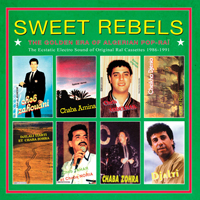
SWEET REBELS:
THE GOLDEN ERA OF ALGERIAN POP-RAI 1986-91 (WeWantSounds WWSLP101)
Do you remember the thrill of first hearing "Hada Raykoum" by Cheb Khaled? It came out in the mid-80s, 40 years ago! And he was a "cheb" or young man back then. We also grooved to Earthworks' compilation Rai Rebels which featured the catchy pop of the red light district of Oran, Algeria, where Khaled was born in 1960. In addition to singing about heartbreak, these rebels were politically astute as the country had gone through a tumultuous decade ending in a separation from France in the 60s. Now we are thrust back into those nostalgic surreal boudoirs with another dose of the same music, drawn from cassettes. This is wonderful and actually includes one of the same Rai Rebels, Cheb Zahouani, with a slamming track. Back then the purists complained that these upstarts were not real musicians, as they used programmed drums and synthesizers instead of ouds and strings. Their defense was they couldn't afford to hire the musicians and they could also carry the gear in the boot of their car which made gigs more lucrative. The compact and efficient mode took over and, as they evolved, the Rai rebels added some live instruments but you still hear the synth strings and bass as well as the sometimes monotonous drum tracks. But then we really came for the vocals, and the occasional flute or trumpet stands out like another voice. From my point of view, back then, I was complaining about the reissue of music digitally and how it so easily got lost, plus there was no booklet or liner notes to study while listening. Now I just sit back and enjoy the mood. The last track sounds like Joujouka music, but it all works in the flow.
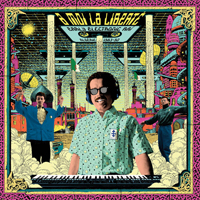
A MOI LA LIBERTE
EARLY ELECTRONIC RAI (ALGERIA 1983-90) (Born Bad Records)
Can we talk about synthesizers? I mean there's good, bad and ugly aspects to the instrument. When it was introduced in the late 70 it was a boon to musicians in third world countries: it was small and portable and heavy pianos or organs will not hold their tune in extreme humidity. So synths were picked up by Rai musicians in Algeria, as well as impoverished musicians in places like Haiti, who could no longer afford a big combo with many horn players and percussionists. As a rule however the early synths are as convincing as say a Melodica in replicating a genuine keyboard sound, whether it was emulating a bass guitar or a spindly guitar lead, or even a modest church harmonium. I once borrowed a Moog from Steve Fisk, who was my neighbor, for a gig with my band. I blarted away merrily with one hand on the two-octave keyboard while twiddling knobs with the other, colliding sine waves, during a "solo." The tune was a punk cover of the Partridge Family's "I think I love you." Fortunately the recording tape had run out. Once you get past the limitations of the sound though there is the problem of performance. It seems to me that most bands got a synth in the 80s, and decided it was fair game for anyone to play. There was nothing holding them back, they just were taken with the novelty of this squeaky loud toy (whether a Prophet 5 or a Yahama DX7, which could store sounds or work as a MIDI bridge between instruments) and pinged away relentlessly at the keys. The drum machines also had their limitations (especially those built-in to keyboards), the Roland TR-808 or its predecessor, the Boss DR3 "Doctor Rhythm," could give you the semblance of a handclap on the one, then little irritating thin claves and a snare fill every third beat. This gets tiresome fast, especially if you are used to the flexibility inherent in performance where the percussionists drive the band to alter the tempo. Now to get to the point, Rai musicians in Algeria made a virtue of the new cheap technology. They abandoned ouds and traditional drums and embraced synthesized keyboards and bass, simple rhythmic drum patterns that created a backing wall for singers to wail. The track by Houari Benchenet is a good example. We remember fondly Cheb Khaled, Cheb Mami and the others who emerged from the Red Light district of Oran, but now here is a well-sorted retrospective of the best of the rest of the genre, from artists that we missed back then. Cheb Hindi kicks off with the title cut and it is a gem, even though it does remind me of the first Khaled album that had us all nodding along. The title is in French; "Freedom for me" it says. The syn-drums plonk along relentlessly but the synth is creative and makes some plaintive background wails. There's even whistling. Looking back now there is an insouciant charm to the sound, loads of echo on everything: the drums, the voice, lots of little twiddly effects, maybe even some actual hand drums caught up in the wash of echo and wall of synth. But it's not all peaches and cream: "Khalouni" by Chab Mohamad Sghir has a truly wretched pair of synths vying for our attention — this one is nigh unlistenable (for me anyway). Cheb Tahar has a very farty bass synth which spoils his otherwise decent effort. Given that these instruments made original sounds, quite different from traditional ones, there is a lot of variety to explore, but overall the melodic qualities are lacking and we have to focus on the singers to find the pleasure in some of the songs. Cheb Kader, a name you might know, has actual percussion instruments and a decent sax player. This track called "Reggae Rai" is no more reggaefied than the others, but does stand out as well-produced. The next track "Zahri mate" by Cheb Hamouda has a reggae bass line and sporty trumpet, but the other instruments are not as well focussed. But Chaba Amel's call and response vocals on "Lala Kusti" is another standout. Thanks to Earthworks, back in the day, we had a small window into this music, and now this compilation reminds us how infectious it could be.
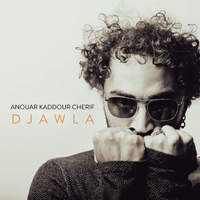
ANOUAR KADDOUR CHERIF
DJAWLA (Riverboat Records TUGCD1133)
Quite distant from the raw percussive tribal stuff we have been getting into lately, comes an album of North African jazz, featuring Anouar Cherif on mandole, and his Swiss sidemen: Clément Meunier on bass clarinet, Hannes Junker on drums, and Antoine Brochot on double bass. I was immediately drawn to the bass clarinet, not just because of the warm woody sound, but because the cover art shows the player laying on his back, a pose adopted by one of the Temperance Seven, from my favorite LP when I was 11 years old. The mandole is a lute-like instrument and the repertoire comes from the Arabo-Andalusian tradition, though more on the Algerian side on the Straits of Gibraltar than the Iberian side. Cherif was homeless in Geneva in 2018, when a Jewish lady took him in. "Autumne Occidental" is his tribute to her. The bass clarinet is noteworthy here and the interplay between the quartet is at a high level. And is that a cuica I hear? In his three years of exile, Cherif has had ample opportunity to reflect on his musical heritage and try to keep it foremost in his mind as he brings his rhythms to the context of a jazz quartet. "Sirocco" seems to bring news of the old quarter of Algiers in hot dry winds that blow from the Sahara before abating in the cool heights of the Swiss alps. "Virgule" is an Indian interlude which has its own inner-mounting flame. Then the African mood comes to the fore with a thumb piano kicking off a loping waltz, that is a return to the Arabo-Andalusian sound in "Amiret Erriyam," the closer.
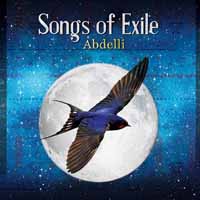
ABDELLI
SONGS OF EXILE (ARC Music EUCD2937)
Our Western perception of Algeria is constantly changing. I recently re-read Algerian-born Albert Camus' The Stranger and some other works, which were favorites of my teen years, because Kamel Daoud's novel The Meursault Investigation made such an impact on me. This led me to the writings of Mohammed Dib. As Anton Ego said, in "Ratatouille," Give me some fresh perspective! Abdelli Abderrahmane is an Algerian Berber who has spent his life being forced from one place to another. First when his mother was pregnant, the French air force bombed his native village in 1957. They took shelter in the forest but were forced out again a year later to the coastal city of Dellys. When he was a teen, Abdelli made a guitar from an oil can with a wooden board and fishing line and sang in public at the Algerian Independence Festival in 1974. He began studying mandola but despite being recognized as a talented musician, there was a ban on singing in his native Kabyle (Berber) tongue. He decided to flee to Europe in 1984 but got stuck in Brussels. Undaunted he began busking outside the station and sure enough was spotted and asked to open for Peter Gabriel, who issued his album Among Brothers on RealWorld. This is traditional Berber music with a minor-key melancholy permeating it. There are woodwinds, guitar, clay drums, krakrebs, violin, from unnamed sidemen, creating a familiar friendly atmosphere for Abdelli's voice and mandola. There also appears to be a cellist on here, adding resonance and woody warmth.
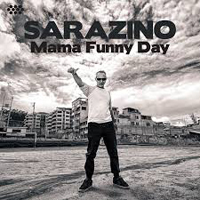
SARAZINO
MAMA FUNNY DAY (Cumbancha CMB-CD-117)
When I first put this on I thought I was accidentally playing two things simultaneously, which might happen it you leave YouTube or some other app running in the background. From the start there is a lot going on. Singer Fellah is an Algerian who grew up listening to reggae, flamenco, rai and French pop. In 1993 Fellah's father was murdered by Islamic radicals and the family forced into exile. At the time Fellah was studying and making music in Montreal but a couple of years later he moved to Quito, Ecuador. The opener is a simple pop ditty with hiphop overtones and a rap by the silly all-style-and-no-substance singer Sandflower. I looked her up on YouTube -- all her songs (that I could stand to watch) are auto-tuned and full of visual flash. Nevertheless this is a catchy kick-off track with four simple chords in an endless round. The same groove then morphs into reggae for the title cut which features another member of the demi-monde called Black Prince (It's not Prince Rogers Nelson, nor the calypsonian of that name, nor indeed the 14th century knight). The next guest is Li Saumet of Bomba Estereo who turns in her usual recognizable rigorous rap this time in concert with Julian Assange who phones in his bit from the Ecuadorian embassy. Consciousness is important in all music but it seems a bit preachy to sample Assange, no matter how relevant his warnings. Each of the 15 tracks has a guest rapper on it, most of them singing in Spanish which is translated in the booklet. Lamine sings in French but "Daddy o, daddy o" or "Go, Johnny, go, go go" are easily understood. And by track six I get the feeling that I am listening to the same four chords over and over. Mostly, however, the techno-derived reggae-inspired grooves are catchy. I am thinking the aim is to fire many rounds (15 three-minute songs) and get at least one hit. "People," track 13, has the recognizable dulcet groan of Toots Hibbert, but again he is largely buried with a lot of slushy production. No musicians are listed, maybe one should not presume there is a band. I think the title is a play on Lee Perry's "People funny boy" or maybe "Mama look deh" by the Pioneers. Maybe I am overthinking it. Ultimately I come to the realization that I must be Babylon.
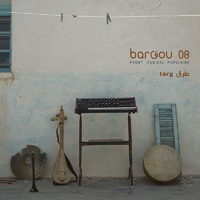
BARGOU 08
TARG (Glitterbeat)
This is a brilliant album, perfectly executed. Nidhal Yahyaoui grew up in the Bargou valley, a forgotten fold of land somewhere between the mountains of northwest Tunisian and the Algerian border. The people there have their own language, part-Berber, part-Arabic, and have been passing down traditional songs and stories for hundreds of years. When the people's revolution began in Tunisia, Yahyaoui's first thought was, what is going to happen to our ancient culture? He decided it was on him to collect the songs of his folk and this became his passion for a decade: finding village elders, old men and women, who could teach him the songs and variations on them. Gradually he assembled a band including some youngsters from the village to perform the music. There's traditional reed instruments, the gasba and zokra; the big tambourine known as bendir; Nidhal himself plays an oud-like instrument called wtar and sings; there's a drummer, and musical director Ben Youssef on Moog. Yahyaoui didn't hesitate to add a Moog synthesizer to the traditional line up to appeal to youth. The band went on the road, performing in festivals from Denmark to Sarawak. This shaped their repertoire and brought the rhythms to the forefront. Instead of overwhelming things, the Moog just fattens the basslines. Back in Bargou they found a place to play, lining the walls with bales of hay, and running the cables to the soundboard in the kitchen, where Ben Youssef recorded with one hand and played synth with the other. Then they laid down their live set in one of the most engaging albums of traditional music I have ever heard. The vocals are raw the solos are not note-perfect, but passionate.
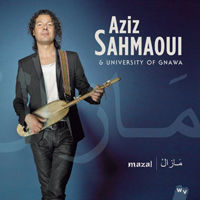
AZIZ SAHMAOUI
MAZAL (World Village WVF 479099)
It's been a while since we heard from Aziz Sahmaoui and his group, known as the University of Gnawa. Mazal was recorded in December 2013 in Paris and is just reaching us in the Americas 18 months later. There was a certain juggernaut momentum to his earlier group, Orchestre National de Barbès which recorded three albums, two of them live. They glid and rumbled along like a camel smelling the oasis beyond the dunes. His new band, University of Gnawa, are more restrained, more polished, but lacking the rough and tumble gallop of their previous incarnation. They know their parts but since none of them are alumni of the former band, it suggests that Sahmaoui had a different vision for his music. It's more introspective and the booklet provides lyrics in arabic, french and english should you want to sit down and follow along. "Lawah-Lawah" does recall the intensity of the ONB live sessions. I forgot what I was listening to during "Jilala" and for a while thought it was old school Brasilian, like bossa nova. But then a Spanish flamenco guitar comes in on "Yasmine" and we return to the Arabo-Andalusian trance. Other guest instruments include a great flute (Naissam Jalal) on two tracks, "Dune for two" and "Firdawss." The band is smaller than ONB (bass, guitar, percussion and a keyboard player who doubles on kora) but guests on sax, violin and tar arrive in timely fashion, apart from Emile Parisien who plays soprano sax on "Water Line" -- he is of the Kenny G school. As well as lead vocals, Aziz plays n'goni and mandole (long-necked mandolin from Algeria). The Barbès live discs stay in heavy rotation at Muzikifan from the Arabia shelf and I hope this one works it way into that space.
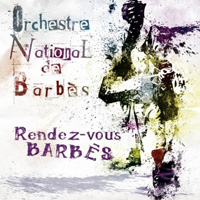
ORCHESTRE NATIONAL DE BARBES
RENDEZ-VOUS BARBES (Le Chant du Monde 274 1878)
The members of this band are Algerian expatriates. For them Barbès is a suburb of Paris, so their rendez-vous is in the heart of France rather than their homeland. Though they are steeped in their culture they have modern attitudes to music, so they incorporate elements of reggae, ska and much else into their sound. Their style of Ska has been domesticated as "Oranais Ska." A heavy dub called "Chorfa" has moody sax and a very stoned backbeat. They call it desert dub, and it features the wonderful Gnawan singer Hafid Bidari. This track reminds me of Gnawa Diffusion: their Bab el Oued Kingston remains one of my favourite North African recordings. Though sometimes the reggae bits seem a bit slack (e.g. "Rod Balek"), when it's just a nyabinghi backbeat on the congas and the guitars and accordions are wailing in their North African scales I am quite transported to the casbah -- even if it is on the périphérique. And there's nothing more majestic than a 17-piece big band gradually building the tempo, nudging each other along to faster licks, greater displays of virtuosity. After some showing off, they get to the heart of the matter: the krakrebs (iron castanets) and guimbri (heavy bass guitar-like lute), an ancient sound, augmented by a guest appearance by the Gnawan band Bania on "Laâfou." I believe this is their first album since the 1998 En Concert, another gem. Lead singer Ahmed Bensidhoum plays bass derbouka and is apparently a Franz Ferdinand fan. Lead guitarist Khliff Miziallaoua admires Jimi Hendrix. Other vocalists double on percussion instruments. They reach out to Flamenco, Jazz, Rai (the title track) and Gnawa styles, drawing on the diverse talents in their ranks for a satisfying tour of the North African musical landscape.
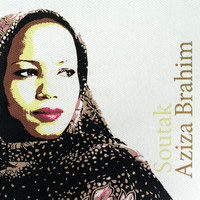
AZIZA BRAHIM
SOUTAK (Glitterbeat GBCD003)
The Sahrawi people of the Western Sahara were displaced by the Moroccans in 1975 and put into camps between Algerian and the Western Sahara or forced into exile. Like the Israeli treatment of Palestinians in their greed for Lebensraum, the stronger nation hopes to wipe out the weaker one by attrition. It was the 70s so no one noticed that napalm and landmines were being tossed about with cruel abandon. Like most Saharan peoples the Sahrawi are intermixed with Berbers and Touregs and also have some relations among Bedouins. Aziza Brahim grew up in this rough refugee environment but managed to get out and go to Cuba during high school. But out of the frying pan into the fire: it was the 90s and Cuba was going through an economic crisis so she was not able to pursue music to university level. She returned to Algeria and started singing in the camps. In 2000 she was able to move to Barcelona and there founded her band Gulili Mankoo. This is her debut release, recorded live. Brahim sings and plays acoustic rhythm guitar and also a small hand-drum, the tabal. She has two Spaniards in her team: Nico Roca on congas and percussion and Guillem Aguilar on bass, and a Malian guitarist, Kalilou Sangaré, who is the featured soloist. Her sister sings back-up. The musicianship and recording are clean, clear and forceful. The small, acoustic ensemble does justice to her voice: she sings in Spanish and her native tongue (complete translations of her lyrics are included in Spanish and English in the booklet). Check out the opening cut here, and her debut video of the second track here.
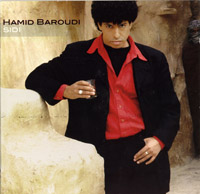
HAMID BAROUDI
SIDI (Vielklang EFA 03231-2)
Here's an instant golden oldie. IJ loaned me this CD that came out in 2001, and it's exactly the kind of fusion album that works. It's Rai music from Algeria so it has Arabic roots feeling but it also has a modern production without going off the deep end. There are samples and synths but also many traditional instruments as well as a small string section. Baroudi plays bindir, djembe and talking drum, and also rhythm guitar. There's a Moroccan gimbri player and even a balafonist from Gambia, but it's essentially Rai music. There are a couple of rap tracks, with an American called Soul S.K. which I can skip, but there's a range of stuff that is very engaging. Good Miles-style trumpet and dubby rhythm underline "Ghaddar," with excellent vocals from Baroudi. "I traveled far to find peace," he sings."Like an albatross I floated above the world and realised it doesn't belong to us." "Walah," featuring the throb of the gimbri, is a song about how life passes by along with wealth and power, so the singer's goal is to turn into a rock painting to survive! Cheb i Sabbah used to play "Gourara" when he deejayed at Nikki's club on Haight Street, SF, and it was always a dance floor filler. Surely an Arabic Groove classic. "Sidi" is a title of respect in arab cultures and Baroudi has earned the appellation.
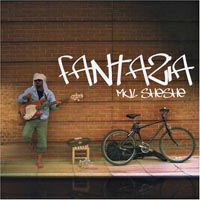
FANTAZIA
MUL SHESHE (World Village 450001)
The cover of this CD makes a visual reference to Gnawa Diffusion's consummate disc BAB EL OUED KINGSTON. At first I was taken aback that anyone would attempt to compare themself to that pinnacle, but Fantazia have succeeded. Fantazia have a lot going for them and this is a great album. Yazid Fentazi on oud is the composer and he is top notch, abetted by Karim Dellali on traditional Maghrebi percussion instruments. MUL SHESHE ("The turbaned one") operates in many layers. Traditional Algerian vocals and gasba coast on top of a bass-n-drum groove with muted trumpet and Celtic fiddle providing solos. The outfit comes from East London where there's been a melting pot for centuries. Being Algerian in London means having to reconcile where you are from with where you are at, and that is what this musical odyssey undertakes. The best demonstration of this is "Fatouma" where a loungey mood is set up and then the oud doubles guitar, but when the muted trumpet comes in, it is challenged by the derbouka. Intelligent use of programming and studio effects makes a real fantasy out of "Khira" which suggests the kif-laden atmosphere of Cheikha Rimitti's outings as much as the streetwise urban groove of Rai. There's hard Algerian vocalising but funk and jazz horns to reel it in and ground it in the Western world. It's a sincere and sophisticated effort.
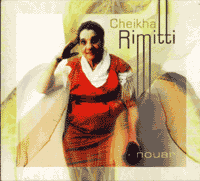
CHEIKA REMITTI
NOUAR (Sonodisc, distributed by Stern's in the US)
Cheika Remitti's album NOUAR made my Pick of the Pops for 2000. It starts out like a Rai album: with drum program, synth, guitar, and Rimitti on bendir, a large tambourine. But then the album shifts to a timeless mood of the Atlas and Rif mountains in a cloud of kif, the thread of Algerian tradition spanning back millenia and held in place by the tenuous pulse of a breathy flute, called gasba. The synth and bass create an atmospheric drone against which Rimitti, who is in her late seventies, sets up her plaint. On the third track, Bellamou Messaoud ("le père du Rai") comes aboard on trumpet. Derbouk, tar, and more percussion instruments are added. This curve into the traditional makes this a really engaging album. The typical rai sound underpins it all, but the tracks with gasba push it towards a timeless folklore that has more staying power and is welcome to my ears.
2000 years ago the Romans showed up and noted the rites of Bou Jeloud, the goat god, whom they equated with Pan. From those rituals we get the concepts "panic" as well as "boogaloo." Most importantly we get the groove, and yes it does veer out of control from time to time. But it's the haunting gasba flute played by Abdelmalek that pushes this album into the transcendental realms.
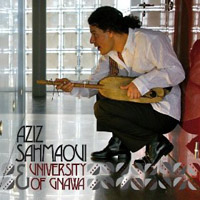
AZIZ SAHMAOUI & UNIVERSITY OF GNAWA
This album came out in 2011 but I've only just heard of it. Typically there are problems getting it from France to the US. Aziz used to front Orchestre National de Barbès, which means, I suppose, we wont be hearing from them again, however I play their En Concert album a great deal; it's definitely on my go-to shortlist. This 40-minute offering is in the same vein as ONB: trancelike choruses, thwoking one-stringed instruments backed up by thudding bass, derbouka, percussion. These are heard to great effect on the second cut, "Maktoube," which creeps along insistently, with an almost whispered chorus, then Aziz breaks out with mad riffs on his little axe. There are lots of excellent soloists on here (sorry i don't have a hard copy with info to relay to you), and it strikes me as good as the ONB material, so possibly it's most of the same guys in a new guise. It's well sequenced: "Black Market" builds to a wild crescendo, then we drop into a ballad with accordion, "Miskina." Things wind up to fever pitch again with guimbri and krakrebs on "Tamtamaki" which blasts off into the stratosphere. This disc is going into my Sure-fire Summer set.
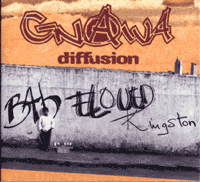
GNAWA DIFFUSION
BAB EL OUED KINGSTON
More cross-pollination is evident in BAB EL OUED KINGSTON by Gnawa Diffusion. As the title implies, it's a hybrid of traditional Moroccan music with Jamaican dancehall-style toasting grafted on. Amaz, the lead singer plays guimbri -- the traditional North African lute and ancestor of the guitar. The other band members are all multi-instrumentalists. The lyrics are in Tagnawit (I guess) and French, with an occasional recognizable dash of English ("Turbo, Valium, Hollywood, Mike Tyson") and comment on the unstable state of Algeria and everyday problems like curfews, stores being shut, potholes in the road, the need to score cannabis. The tracks alternate between traditionally scored and drum-and-synth-driven ones and of course occasionally fuse both styles, as on "H'moun Zawalia" a lament for the plight of Africa today. The purely traditional tracks, like "Chara' Allah" are outstanding, but the sequencing is so good that the album flows like a magic carpet ride, dipping in and out of different musical moods. There are even a few samples and snippets of ambient sound to add a Berber authenticity to the more rock-oriented tracks.
The final track "Gazel au fond de la nuit" uses a moving poem by the great French poet Louis Aragon about the fragility of love; the atmospheric interepretation by Gnawa Diffusion is a fitting reverie-infused coda to this wonderful new release.
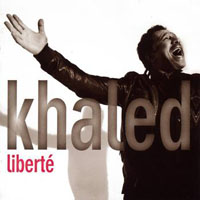
KHALED
LIBERTE (Wrasse)
I keep having this discussion with record label folks. They e-mail me about a hot new album and I write back and ask if they will send me a copy to audition. They reply, sure, log in to our secure server and download it. I tell them, no, thanks, I would rather have the disc, with the liner notes and a case so I can file it in my library, otherwise it will get lost. No one has discs anymore, they tell me, it's all downloads on iTunes. So I try to explain I don't like that, even if it is environmentally friendly not to send a plastic box in a paper bag on a diesel-powered truck halfway across the country. Here are the problems with downloads: First, the bit rate: it doesn't sound so good on my fabulous Siefert Research speakers. Ah, they admit, but then nothing sounds as good as vinyl! OK, first point to me. Second the medium: I have folders of downloaded music, a lot of which is culled from the blogosphere. While I have qualms that some poor African is not getting his 5 cents royalty from file-sharing, it also disappoints me that this will become the standard and scratchy disks will become acceptable. Why go to the trouble to track down master tapes, license them and reissue them properly when everyone has a pile of needle-drops from worn-out discs? When I find time I audition the downloads, & if the quality is acceptable, I burn it to disc and print the cover. So the ecologically unsound plastic and paper is still involved, though not the UPS driver who passes right by. I don't want to clutter up my hard drive with MP3 files; besides, I just had a hard disk crash and lost all the music that was on my iTunes. Yes, I know you are supposed to back up your files, like brushing your teeth, but who is that conscientious? Sometimes I get distracted and forget to label discs, so I have a smoking CD of lute or oud and guitar and NO IDEA who it is by, so I cannot recommend it to you. But finally I gave in and downloaded the Cheb Khaled album because I have not heard anything from him since Ya-Rayi five years ago. It's good, he does his old hits again but they are fuller, more developed. He has given up on the cheap sound of synth and drum machine which actually suited the emergent Rai sound heard on cheap car speakers in the souk, and he has more acoustic instruments, real strings, in fact a bunch of em, with real brass, oud, & hand drums. But another problem arose, I clicked on "liner notes" and got a powerpoint file which my computer didnt like the look of so there was no way to access it, then I clicked on "download cover" and got this message "The image cannot be displayed, because it contains errors," so there you go. Another bloody blank CD titled track 1, track 2, and so on. I had to bug Garrett, the promo guy, for track info because the cover link didn't work. (At least some bloggers know how to make a resized JPG of an LP cover and put it in the folder with the music files!) So I have no info on this album, sorry. The playlist is on the Sterns' website, where you can sample it (& where I captured the cover image), but again this assumes you are on line while listening to music. You will enjoy it I am sure, but like me you might be fidgeting around wishing you had a liner note or two to inform your listening experience.
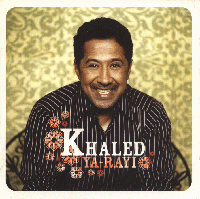
KHALED
YA RAYI (Wrasse Records 127X)
This is a two-disc set, the second disc being a DVD. I borrowed it from IJ who had left the DVD in his machine so I didn't get to see Khaled, just hear him. There was also some discussion a month ago that the American release was going to be remixed to be more palatable to an American audience. I'm not sure if that meant they were going to switch from Arabic to English and have him do "The Star-Bungled Spanner" or "Onward Christian Soldiers," but as it is, this disc sounds fine. There's flamenco guitar and classical piano but mainly the stone groove you expect from the master of the Rai dancehall. "Ya-Rayi" means "my opinion," but it's more "my story." Khaled first hit with the incredible HADA RAYKOUM (Stern's 1986) which planted Rai music in our consciousness. His collaborations with trumpeter Bellemou Messaoud gave us another dimension. In 1992 Don Was produced the eponymous LP which included "Didi Didi," a top ten hit in France. N'SSI N'SSI followed the next year and in 1996 he topped the charts again with "Aicha," but then he went a bit off track. Two years ago I interviewed him before his last California concert; he told me when he was ten he started a band that aped the Jackson Five, they even had a minor hit but his father found out and punished him. When he opened for HAKIM "the Lion of Egypt" in Berkeley in 2002 he seemed past his prime, but YA RAYI is a regrouping and a restatement of what he's all about. There's still touches of synth and the mechanical beat that became so monotonous, but he has brought the traditional instruments back to the fore, which is a welcome sign. Maurice El Medioni, legendary Jewish blues pianist from Oran appears.
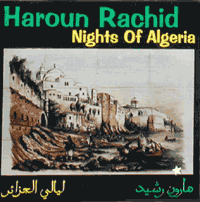
HAROUN RACHID NIGHTS OF ALGERIA (united one records)
Haroun Rachid's NIGHTS OF ALGERIA explores the traditional sound of Algeria in five ten-minute long jams (each a medley of two or three tunes), with tar, guitar, banjo, canoon, violin and darbuka. Rachid has an interesting voice and doesn't sound like he's complaining which is one aspect of Arabic singing that turns off many Western listeners. A track titled "Andalousia" has a waltz beat then progresses through something that sounds a bit like "Havana gila" -- the Cuban lizard song -- (to my untutored ears) & goes into a rave-up outro.